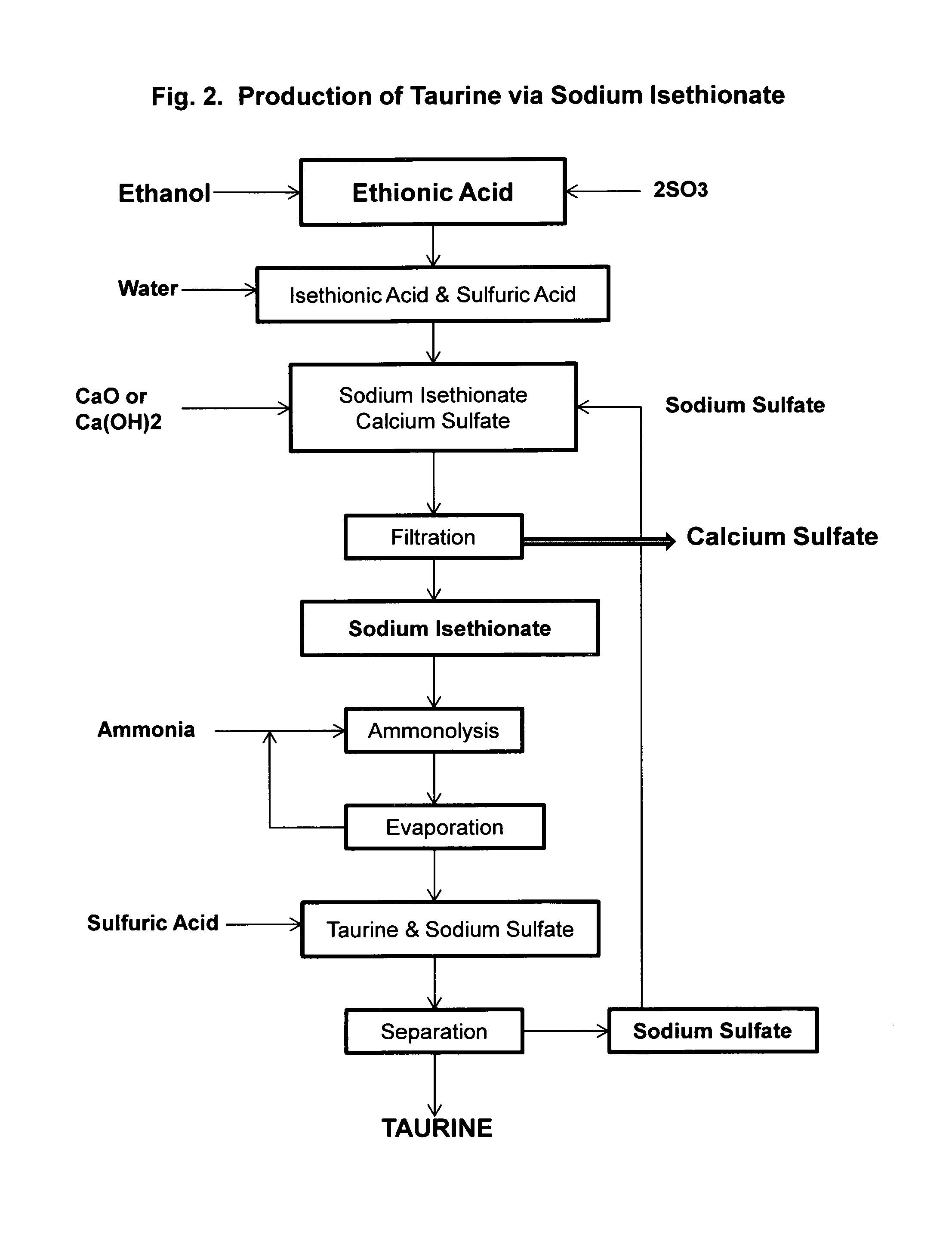Process for the production of taurine from ethanol
a technology of ethanol and ethionic acid, applied in the field of taurine, can solve the problems of difficult handling of ethylene oxide and toxic two-starting materials
- Summary
- Abstract
- Description
- Claims
- Application Information
AI Technical Summary
Benefits of technology
Problems solved by technology
Method used
Image
Examples
example 1
[0040]Ethionic acid, 206 g, prepared according to the method of U.S. Pat. No. 3,637,793, is dropwise added to a cooled solution of 1,000 mL aqueous ammonia (25%). The solution is then placed in a 2 L autoclave and heated to 180° C. for two hours. HPLC analysis indicates there are 87.5 g of taurine formed in the solution. After excess ammonia is removed by boiling and the solution concentrated to about 500 mL under vacuum distillation. After cooling to room temperature to yield a crystalline suspension, in which the pH is 5.6. After filtration, crude taurine is obtained in an amount of 68.4 g. Further concentration of the mother liquor yields a mixture of taurine and ammonium sulfate.
example 2
[0041]Ethionic acid, 206 g, is diluted with 800 mL of deionized water and heated to reflux for three hours to complete the hydrolysis to an aqueous solution containing isethionic acid and sulfuric acid, to which 80 g of sodium sulfate is added. About 120 g of calcium hydroxide is added slowly to bring the pH to 8-9 and a white slurry of calcium sulfate is formed. After filtration and washing with deionized water, an aqueous solution of sodium isethionate is obtained.
[0042]Into a 2 L autoclave is added the solution of sodium isethionate, and 2 g of sodium hydroxide. The solution is then saturated with ammonia to about 25% of ammonia. Ammonolysis is carried out at 220° C. under the autogenous pressure of about 140 bar for 2 hrs. HPLC analysis indicates the formation of 110 g of taurine in the solution. After removal of the excess ammonia, sulfuric acid is used to liberate taurine to yield a mixture of taurine and sodium sulfate.
example 3
[0043]Ethionic acid, 206 g, is diluted with 800 mL of deionized water containing 80 g of sodium sulfate. About 120 g of calcium hydroxide is added slowly to bring a pH to 7-8 while the temperature is controlled at 35-50° C., then to a pH of 10-11 while the temperature is raised to 70-80° C. from the heat of neutralization. The temperature of the slurry is maintained at 70-80° C. for about 1 hour and lowed to 50° C. Dilute sulfuric acid is used to adjust the pH of the slurry to 7-8. The formed sodium vinyl sulfonate is freed from the precipitated calcium sulfate by filtration and is obtained as a clear and virtually colorless solution.
[0044]To the aqueous solution of sodium vinyl sulfonate, placed in a 2 L autoclave, is saturated with ammonia to about 25%, and is added 2 g of sodium hydroxide. The ammonolysis reaction is carried out at 220° C. under the autogenous pressure of about 140 bar for 2 hours. HPLC analysis indicates the formation of 95 g of taurine in the solution. After re...
PUM
| Property | Measurement | Unit |
|---|---|---|
| pressure | aaaaa | aaaaa |
| temperature | aaaaa | aaaaa |
| molar ratio | aaaaa | aaaaa |
Abstract
Description
Claims
Application Information
 Login to View More
Login to View More - R&D
- Intellectual Property
- Life Sciences
- Materials
- Tech Scout
- Unparalleled Data Quality
- Higher Quality Content
- 60% Fewer Hallucinations
Browse by: Latest US Patents, China's latest patents, Technical Efficacy Thesaurus, Application Domain, Technology Topic, Popular Technical Reports.
© 2025 PatSnap. All rights reserved.Legal|Privacy policy|Modern Slavery Act Transparency Statement|Sitemap|About US| Contact US: help@patsnap.com



